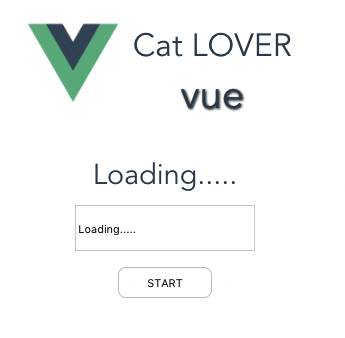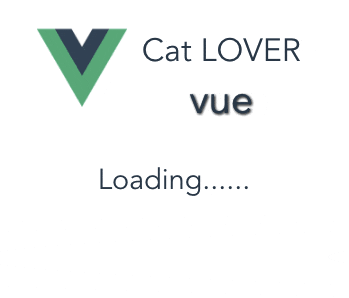Index
1.VueCLIでHelloWorld
2.Vue.jsでフォームを使おう
3.Vue.jsで単一ファイルコンポーネント
4.Vue.jsでAPI通信
5.Vue.jsで猫検索アプリ作成
6.おまけ
1. 前提条件
2.axiosとmockeyをインストール
VueでAjaxするには何を使えばいいの?っていう話が調べていくときな臭い感じ・・・・・
https://jp.vuejs.org/2016/11/03/retiring-vue-resource/
とりあえず、上記の公式コミュニティでおすすめされてる、axiosを使ってみたいと思います。
npm install axios --save
npm install -D mocky --save
3. mockeyのインストールとAPIスタブ作成
3.1 スタブAPI作成
var mocky = require('mocky');
mocky.createServer([{
// simple GET route without request body to match
url: '/profile',
method: 'get',
headers: {'Content-type': 'text/json'},
res: {
status: 200,
headers: {'Content-type': 'text/html', 'Access-Control-Allow-Origin': 'http://localhost:8080'},
body: JSON.stringify({'nickname': ''})
}
},
{
// simple GET route without request body to match
url: '/profile_wait',
method: 'get',
headers: {'Content-type': 'text/json'},
res: function(req, res, callback) {
setTimeout(function() {
callback(null, {
status: 200,
headers: {'Content-type': 'text/html', 'Access-Control-Allow-Origin': 'http://localhost:8080'},
body: JSON.stringify({'nickname': ''})
});
}, 1000);
}
},
{
// POST route with request body to match and respose with status, headers and body
url: '/profile',
method: 'post',
req: '',
headers: {'Content-type': 'text/json'},
res: {
status: 200,
headers: {'Content-type': 'text/html', 'Access-Control-Allow-Origin': 'http://localhost:8080'},
body: JSON.stringify({'status': 'ok'})
}
},
{
// PUT route with dynamic response body
url: '/profile',
method: 'put',
req: '',
headers: {'Content-type': 'text/json'},
res: {
status: 200,
headers: {'Content-type': 'text/html', 'Access-Control-Allow-Origin': 'http://localhost:8080'},
body: JSON.stringify({'status': 'ok'})
}
},
{
// DELETE route with dynamic response body
url: '/profile',
method: 'delete',
req: '',
headers: {'Content-type': 'text/json'},
res: {
status: 200,
headers: {'Content-type': 'text/html', 'Access-Control-Allow-Origin': 'http://localhost:8080'},
body: JSON.stringify({'status': 'ok'})
}
}]).listen(4321);
3.2 起動
node mock.js
3.3 動作確認
# GET
curl "http://127.0.0.1:4321/profile"
# POST
curl -d "{'nickname': 'test'}" http://127.0.0.1:4321/profile
# PUT
curl -v -X PUT -d "{'nickname': 'test'}" http://127.0.0.1:4321/profile
# DELETE
curl -v -X DELETE -d "{'nickname': 'test'}" http://127.0.0.1:4321/profile
4. axiosを使ってAPI通信
下記の記述をScene1.vueに追加してAPIデータ取得が非同期である事を確認してみましょう。profile_waitを読んでいるので少し遅れてコンソールにレスポンスが出力されます。
.......
import axios from 'axios'
export default {
created: function () {
axios.get('http://127.0.0.1:4321/profile_wait')
.then(response => {
console.log(response.data) // mockData
console.log(response.status) // 200
})
}
}
.......
5. VuexのインストールとStoreの書き換え
npm install vuex install --save
5.1 非同期通信の実践
まず、PropertyStore.jsをVuexに合わせて書き換えていきます
import Vue from 'vue'
import Vuex from 'vuex'
import axios from 'axios'
Vue.use(Vuex)
// データストア
var PropertyStore = new Vuex.Store({
state: {
property: {
nickname: 'Loading.....'
}
},
mutations: {
increment (state, n) {
state.count += n
},
getUser (state, response) {
state.property.nickname = response.data.nickname
},
setUser (state, nickname) {
state.property.nickname = nickname
}
},
actions: {
getUser ({ commit }) {
axios.get('http://127.0.0.1:4321/profile_wait')
.then(response => {
if (response.status === 200) {
commit('getUser', response)
}
})
},
setUser ({ state, commit, rootState }) {
if (state.property.nickname.length <= 3) {
throw new Error('3文字以上入力してください')
}
axios.post('http://127.0.0.1:4321/profile')
.then(response => {
if (response.status === 200 && response.data.status === 'ok') {
commit('setUser', state.property.nickname)
} else {
throw new Error('レスポンスエラー')
}
})
}
}
})
export default PropertyStore
次に、Scene1に処理を追加します。
.....
import InputText from './forms/InputText'
import PropertyStore from '../models/PropertyStore.js'
export default {
created: function () {
}
}
// ユーザー情報取得
PropertyStore.dispatch('getUser')
// コンポーネントを登録
Vue.component('nickname-header', NickNameHeader)
.....
最後に、ボタンアクションでバリデーションしていた部分を書き換えます。
.....
methods: {
validate: function (event) {
try {
this.$data.sharedState.dispatch('setUser')
this.$router.push('/scene2')
} catch (e) {
alert(e.message)
}
}
}
.....
スタブでレスポンスの返却を1秒まってから行っているので、初期値としてnicknameに入れているloadingという文字が1秒後に書き換えられる事が確認できました。
6. Loading画面からのフォーム表示
上記 5.の実習では、フォームを表示した後にデータ入力が可能な状態になるので、ユーザービリティがよくありませんでした。
ここで、再度リファクタリングをしてStoreのステータス管理とUIを結びつけて行きます。
ここでは、v-show というsyntaxを利用します。
まずは、ステータス管理用のconfigを作成します。
export const StatusConfig = {
INITIALIZE: 0,
DATA_LOADED: 1
}
PropertyStoreでステータス管理ができるようにコードを書き換えます。
- 先程作成した、StatusConfigをインポートします。
- stateの中にstatus=StatusConfig.INITIALIZEを追加、代入しましょう。
- mutations内のgetUserの中でstatusをStatusConfig.DATA_LOADEDに書き換えます。
import {StatusConfig} from '../config/Status.js'
.....
state: {
status: StatusConfig.INITIALIZE,
property: {
nickname: 'Loading.....'
}
},
.....
mutations: {
.....
getUser (state, response) {
state.property.nickname = response.data.nickname
state.status = StatusConfig.DATA_LOADED
},
最後にScene1.vueを書き換えます。
- StatusConfigのインポート
- computedの中にis_loading関数を追加
- <template></template>内でLoading中に表示するものとLoading後に表示するものを書き分けます。
<template>
<div class="scene1">
<div v-show="is_loading">
Loading......
</div>
<div v-show="!is_loading">
<nickname-header></nickname-header>
<input-text></input-text>
<input-button></input-button>
</div>
</div>
</template>
........
import PropertyStore from '../models/PropertyStore.js'
import {StatusConfig} from '../config/Status.js'
........
export default {
computed: {
is_loading: function () {
return PropertyStore.state.status === StatusConfig.INITIALIZE
}
}
}
........

